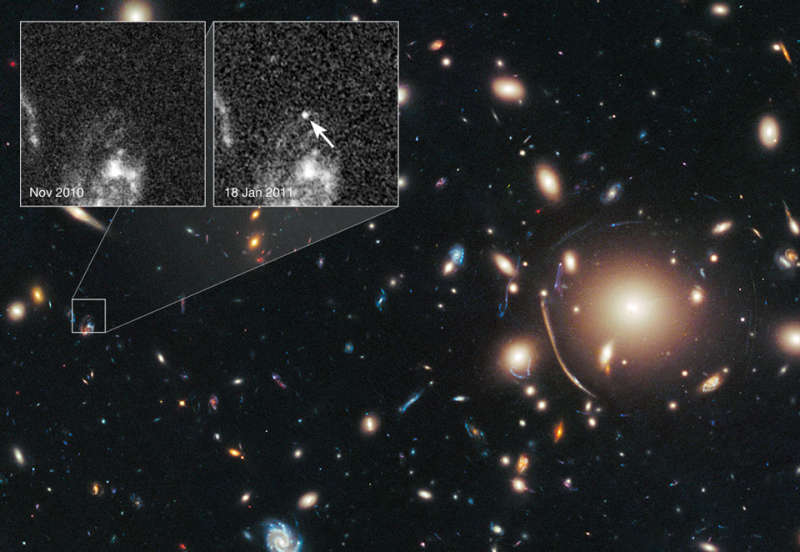Explanation: How do you calibrate a huge gravitational lens? In this case the lens is the galaxy cluster Abell 383, a massive conglomeration of galaxies, hot gas, and dark matter that lies about 2.5 billion light years away (redshift z=0.187). What needs calibrating is the mass of the cluster, in particular the amount and distribution of dark matter. A new calibration technique has been tested recently that consists of waiting for supernovas of a very specific type to occur behind a galaxy cluster, and then figuring out how much the cluster must have magnified these supernovas through gravitational lensing. This technique complements other measures including computing the dark matter needed to contain internal galaxy motions, to confine cluster hot gas, and to create the gravitational lens image distortions. Pictured above from the Hubble Space Telescope, galaxy cluster A383 shows its gravitational lens capabilities on the right by highly distorting background galaxies behind the cluster center. On the left is a distant galaxy shown both before and after a recent revealing supernova. To date, calibration-quality supernovas of Type Ia have been found behind two other galaxy clusters by the Cluster Lensing And Supernova survey with Hubble (CLASH) project.
Follow APOD on:
Facebook,
Google Plus,
or
Twitter
1999 2000 2001 2002 2003 2004 2005 2006 2007 2008 2009 2010 2011 2012 2013 2014 2015 2016 2017 2018 2019 2020 2021 2022 2023 2024 2025 |
Январь Февраль Март Апрель Май Июнь Июль Август Сентябрь Октябрь Ноябрь Декабрь |
NASA Web Site Statements, Warnings, and Disclaimers
NASA Official: Jay Norris. Specific rights apply.
A service of: LHEA at NASA / GSFC
& Michigan Tech. U.
|
Публикации с ключевыми словами:
galaxy cluster - dark matter - сверхновые типа Ia - Скопление галактик - гравитационное линзирование
Публикации со словами: galaxy cluster - dark matter - сверхновые типа Ia - Скопление галактик - гравитационное линзирование | |
См. также:
Все публикации на ту же тему >> | |
